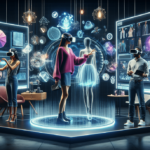Exploring the Possibilities of AR, VR, and Ecommerce
The world of ecommerce has been growing rapidly over the years, with businesses increasingly moving towards online platforms to showcase their products and services. To make online shopping more immersive and engaging, the adoption of augmented reality (AR) and virtual reality (VR) technologies has seen a steady rise. This article explores how AR and VR can be incorporated into ecommerce and the potential benefits that come with their integration.
AR, VR, and Ecommerce: A Match Made in Heaven
AR and VR technologies provide unique opportunities for ecommerce businesses to create more engaging and interactive shopping experiences for their customers. By incorporating AR into product pages, customers can visualize products in a more interactive way—zooming in and out, rotating, examining the product, and even seeing how it would look in their own environment. This level of interactivity surpasses traditional static images, helping to build trust in the product and leading to increased conversions.
Enhanced Product Visualization
With AR, customers can:
- Zoom and Rotate: Get a detailed view of the product from all angles.
- Environment Placement: See how the product fits into their own space using their smartphone or tablet.
- Interactive Features: Engage with product features in real-time.
Reduction in Product Returns
AR and VR can significantly reduce the number of returns by providing customers with a better understanding of the product's size, color, and overall appearance before purchase. This minimizes misunderstandings and miscommunications about the product, leading to fewer returns and exchanges.
The Rise of AR and VR in Ecommerce
The use of AR and VR in ecommerce has been on the rise, with more businesses recognizing their potential benefits. According to a Gartner report, it is predicted that by 2025, 70% of enterprises will be experimenting with immersive technologies for consumer and enterprise use, and over 25% will have deployed them to production.
Increased Adoption Rates
Businesses across various sectors are adopting AR and VR to enhance customer experiences. For example:
- Retail: Virtual try-ons and interactive product demos.
- Real Estate: Virtual property tours.
- Automotive: Virtual showrooms and test drives.
Benefits of Incorporating AR and VR in Online Shopping
Incorporating AR and VR into ecommerce offers numerous benefits beyond enhanced interactivity and engagement:
Reduction in Returns
By allowing customers to visualize products in their own environment, businesses can reduce the likelihood of returns, saving time and costs associated with processing returns.
Increased Customer Loyalty
Providing a positive and engaging shopping experience through AR and VR can foster customer loyalty, encouraging repeat purchases and long-term relationships.
Boosted Sales
Immersive and interactive experiences can create a sense of urgency and excitement around products, leading to increased sales. According to a Business Insider report, AR can lead to a 40% increase in purchase intent.
Personalized Recommendations
By analyzing customer data and behavior, businesses can use AR and VR to provide personalized recommendations and product suggestions, enhancing the overall shopping experience.
How AR and VR are Changing the Way We Shop Online
AR and VR are revolutionizing online shopping by offering more immersive and personalized experiences. Customers can:
Detailed Product Exploration
Explore products in greater detail, including features and functionalities that are not easily showcased through static images.
Personalized Shopping Experiences
Virtual stores tailored to individual preferences and shopping histories make the shopping experience more enjoyable and relevant.
Improved Supply Chain Efficiency
AR and VR can optimize inventory management and reduce restocking times, ensuring faster and more accurate order fulfillment.
The Future of Ecommerce with AR and VR Technology
The future of ecommerce with AR and VR technology looks promising, with continuous advancements expected to drive even more immersive and interactive shopping experiences. Key future trends include:
Advanced Personalization
Further integration of AI with AR and VR will enable even more personalized shopping experiences, tailored to individual customer preferences and behaviors.
Increased Accessibility
As AR and VR technologies become more affordable and widespread, smaller businesses will have greater opportunities to adopt these technologies.
Enhanced Virtual Showrooms
Virtual showrooms will become more sophisticated, allowing customers to interact with products in ways that closely mimic in-person shopping experiences.
Examples of Successful AR and VR Integration in Ecommerce
Several companies have successfully integrated AR and VR into their ecommerce strategies:
Ikea Place
Ikea’s AR app, Ikea Place, allows customers to visualize furniture in their own homes before making a purchase, enhancing customer confidence and satisfaction.
Sephora Virtual Artist
Sephora's Virtual Artist uses AR to let customers try on makeup virtually, improving the online shopping experience and increasing engagement.
Overcoming the Challenges of Implementing AR and VR in Ecommerce
While AR and VR offer significant benefits, businesses must navigate several challenges to successfully implement these technologies:
High Implementation Costs
The initial costs of developing and integrating AR and VR technologies can be high. However, as technology advances, these costs are expected to decrease.
Lack of Standardization
The absence of standardized AR and VR platforms can make it difficult for businesses to create experiences that are compatible across different devices and platforms.
Technical Expertise
Developing AR and VR experiences requires specialized skills and expertise, which may be a barrier for some businesses.
Which Industries Can Benefit Most from AR and VR Ecommerce Solutions?
While AR and VR can enhance a wide range of industries, some stand to benefit more significantly:
Fashion and Beauty
Allowing customers to virtually try on clothing and makeup can reduce uncertainty and increase purchase confidence.
Furniture and Home Decor
Visualizing furniture in a home setting helps customers make informed decisions about size, style, and fit.
Automotive and Real Estate
Virtual showrooms and property tours provide customers with comprehensive insights into products and properties without needing to visit in person.
Tips for Creating Compelling AR and VR Experiences for Online Shoppers
To maximize the effectiveness of AR and VR in ecommerce, consider the following tips:
Simplicity and Usability
Keep AR and VR experiences simple and user-friendly to ensure customers can easily navigate and interact with the technology.
Mobile Optimization
Ensure that AR and VR experiences are optimized for mobile devices, as many users will access these features via smartphones and tablets.
High-Quality Visuals
Use high-resolution images and realistic 3D models to create immersive and believable experiences.
The Role of AI in Enhancing AR and VR Ecommerce Experiences
Artificial Intelligence (AI) plays a crucial role in enhancing AR and VR experiences in ecommerce by:
Data Analysis and Personalization
AI can analyze data collected from AR and VR interactions to gain insights into customer behavior and preferences, enabling more personalized shopping experiences.
Improved User Interaction
AI-driven chatbots and virtual assistants can guide customers through AR and VR experiences, providing real-time support and recommendations.
How Traditional Brick-and-Mortar Stores Can Compete with AR and VR Ecommerce Stores
Traditional brick-and-mortar stores can still compete with AR and VR-enabled ecommerce by offering unique and personalized in-store experiences that cannot be replicated online:
Personalized In-Store Services
Offering personalized consultations, product demonstrations, and hands-on experiences can differentiate physical stores from online competitors.
Hybrid Shopping Experiences
Integrating AR and VR in-store can blend the benefits of physical and digital shopping, providing customers with the best of both worlds.
Ethical Concerns Surrounding the Use of AR and VR in Ecommerce
As with any technology, there are ethical considerations when implementing AR and VR in ecommerce:
Data Privacy
Businesses must ensure they protect customer data collected through AR and VR interactions and use it responsibly.
Realistic Representations
While AR and VR aim to provide realistic product views, there is a risk of creating unrealistic expectations or perpetuating harmful stereotypes.
The Impact of COVID-19 on the Adoption of AR and VR Technology in Ecommerce
The COVID-19 pandemic accelerated the adoption of ecommerce and, consequently, the integration of AR and VR technologies. With physical stores closed or limited, businesses sought innovative ways to engage customers online:
Increased Online Shopping
The shift to online shopping during the pandemic highlighted the need for more immersive and interactive online experiences.
Investment in Technology
Many businesses invested in AR and VR technologies to enhance their online presence and provide customers with engaging shopping experiences.
What's Next for the Intersection of AR, VR, and Ecommerce?
The intersection of AR, VR, and ecommerce continues to evolve, promising even more innovative and immersive shopping experiences in the future:
Integration with Emerging Technologies
Combining AR and VR with other technologies like AI, blockchain, and the Internet of Things (IoT) will create more sophisticated and secure shopping environments.
Enhanced Interactivity
Future AR and VR experiences will offer even greater interactivity, allowing for more detailed customization and real-time collaboration between customers and businesses.
Overall, the adoption of AR and VR technologies in ecommerce is a positive trend that offers businesses a unique opportunity to enhance the shopping experience for their customers and increase sales. While there are challenges to overcome, the potential benefits make it a worthwhile investment. Expect to see continued innovations in AR and VR within the ecommerce landscape in the coming years.




















